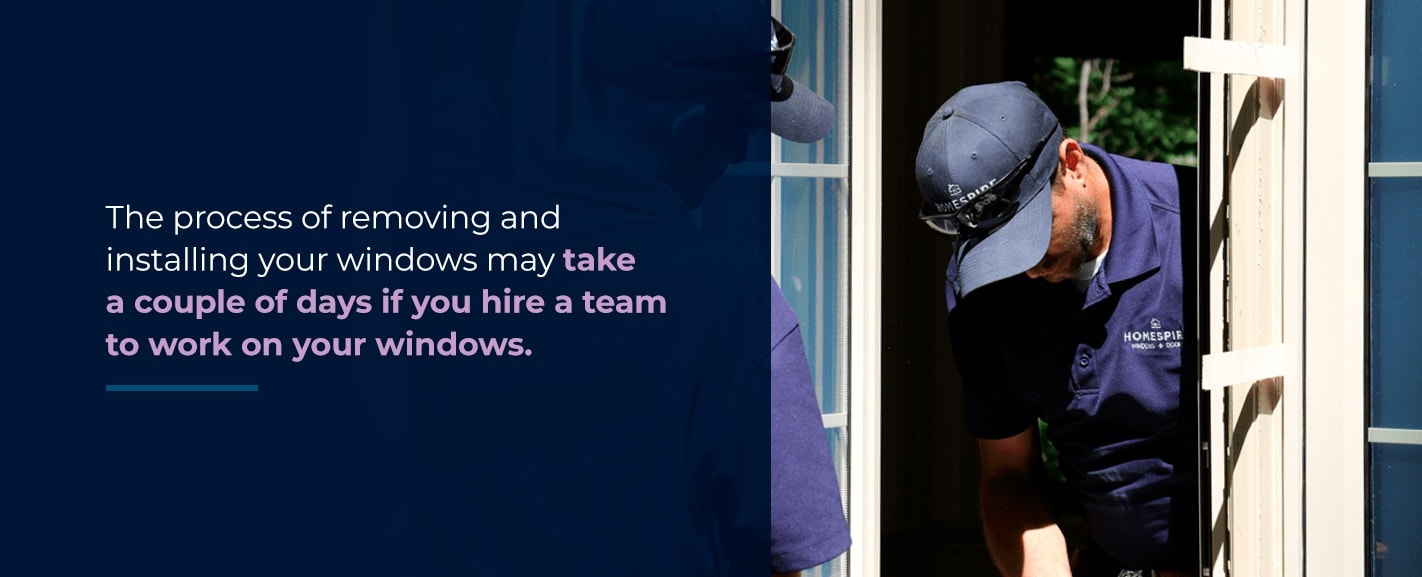Installing new, energy-efficient windows can increase the value of your home and provide you with a comfortable living space. It might be a good idea to replace these essential elements of your house if you experience drafts and cold air. By upgrading your windows, you’re likely to save money on your utility bills, repair any damage to your windows, and increase your home’s security.
When you hire our professional window installers at Homespire Windows and Doors, we’ll give you a new set of energy-efficient windows to enhance the quality of your living space. We follow an installation process to create a painless, stress-free experience as we address your common home window problems. Use this guide to help you understand how window installation works, so you can prepare yourself for this home renovation project.
How to Find Experienced Window Installers
The window installation process can be tricky, so you need to find a trustworthy contractor who can handle it. Research online reviews to discover their reputation and how well they work with other customers. You can also use these additional tips for finding high-quality professionals to install your windows:
- Find out what you need: A reliable window installer will inspect your windows and figure out the best window treatment for your property. Keep in mind that if you want to change the style or size of your window, a contractor may have to make changes to your walls, which will affect the price. Knowing what type of project you’d like to do will help you find the appropriate contractor.
- Request their credentials: A window replacement company should have reliable workers’ compensation and liability insurance to prevent costly damage during your project. Before you hire a contractor, verify their certifications from their insurance agency. Be careful to avoid uninsured contractors, because they’ll end up making you pay if they fall or get hurt on your property. Also, ask if their installers are properly trained and undergo background and drug testing. A reputable company will ensure the installers working in your home are properly cleared and trained before working in your home.
- Ask questions: If you’ve never replaced your windows before, you may have some questions about how the process works. As you meet with various contractors, ask them questions about the quality of their products and what to expect while they work in your home.
- Compare costs: How much does it cost to install a window? It depends on what the window replacement contractor charges in your local area. While it may be tempting to choose with the cheapest option, make sure you’re paying for quality materials and exceptional customer service. Read the fine print of what your estimate includes before signing any contracts.
At Homespire, our installers are our employees, so we control the process from start to finish. We take safety very seriously, and we have safeguards in place to protect the security and health of our customers, communities, and employees.
How to Get the Proper Measurements for Replacement Windows
Before you can have your new windows installed, you must get the precise measurements. Having the proper dimensions for the window opening is essential for providing an airtight, long-lasting seal and protection against various weather conditions throughout the year. Once you hire a contractor, schedule an appointment for them to inspect and measure your windows.
Follow these steps to find the exact measurements of your window opening:
- Inspect your windows: All windows have unique qualities, so the way your contractor goes about installing new ones may be different with each project. They’ll note any details that may affect the installation of your windows, including the casing and frames.
- Measure the width and height: Using a tape measure, the contractor will measure the rough opening. They determine the width at the bottom, top, and middle, and the height at either side and the center.
- Make adjustments for fitting: To figure out what size to order, the contractor should use the smallest dimensions. Outside, the window should be slightly thinner and shorter than the smallest width and height dimensions to allow a good fit.
- Order your windows: After the contractor collects the measurements, they will order what you need from the manufacturer. You don’t have to worry about picking up or delivering the units but keep in mind that it may take a couple of weeks to design your custom windows.
Homespire is a reputable contracting company that offers you custom replacement windows to give your home a brand-new appearance. Our team of professionals can figure out the exact measurements you need, so you don’t have to make any expensive repairs later.
How to Remove an Old Window
Once the contractor has your windows ready, you can schedule a date to install your new windows. The process of removing and installing your windows may take a couple of days if you hire a team to work on your windows. Usually, one set of installers will bring in your new windows, and another set will remove the old ones. Homespire Windows and Doors installers are trained to remove and install windows, so the same team can usually complete most projects in a single day. While you don’t have to watch them too closely, you should be within calling distance in case they have a question.
When they arrive, they’ll prepare the site by removing all your furniture from around your windows and laying down a drop cloth on the floors and furniture they can’t move. They’ll take every precaution necessary to make sure your property stays clean while they work. The contractor and their team will remove the old window by following these steps:
- Remove the storm window: You may have storm windows on the outside of your windows to provide additional protection against the wind. The contractors will take out these protective layers first.
- Mark the window frame: Using a utility knife, the contractor will create a mark along the edge of the storm window frame. After removing the screws, they’ll take off the frame with a putty knife or a pry bar.
- Cut through the weather barrier: Your windows have a weather-resistant barrier featuring sheets of specially coated materials that keep moisture from the walls. The installation company will carefully cut into this barrier, so the new window can fit into the older system.
- Take out sash weights or springs: Older windows often have sash weights or springs that keep the window balanced. To remove sash weights, the contractor will cut the cords and let the weight fall inside the frame. The contractor will remove sash springs by cutting the plastic covers around the ones near the top of the window and removing the screws holding them in place.
- Locate and score the stops: If you have older wooden windows, they may have pieces holding the sashes. Whether the contractor works on the inside or outside, they should leave the stops on the opposite side. Using a utility knife, make a mark where the stops meet the frame and pry them off cleanly. If they can’t, they would need to cut them out using an oscillating saw.
- Remove the sashes: After cutting the stops, the contractor will remove the top sash, where the upper panel of your window goes. When they remove the parting stop, they’ll take out the lower sash, as well.
- Clear away the sealants: The contractor will need to clean the previous sealant area that kept the old window in place, so the new sealant can adequately adhere to the opening. They’ll need to use a cleaning product and cutting knife that works with the type of caulk on your old windows.
- Dispose of old materials: As the contractor removes your old window, they’ll try to make as little dirt and debris as possible. They’ll also dispose of the old materials, recycling old pieces, and trashing parts that were contaminated by mold.
Install Exterior Trimming and Weatherproofing
The contractor will install the exterior trimming and weatherproofing before and after installing the windows. Sealing the area before installing the windows prevents moisture from getting stuck between the panes. Weatherproofing after installation secures the window in place and increases the energy-efficiency of your home. A reliable contractor will adequately install trimming and insulation around your windows to save you money in repairs and replacement.
Here is the technique for insulating your windows:
- Install flashing: Flashing is the material used to weatherproof a window. Window installers apply flashing around the window from the bottom up, so rainwater and other moisture runs off the lower portion. They usually overlap the existing flashing pieces from the bottom up, so the water doesn’t go behind it.
- Apply sealant: Along with flashing, sealant around the weather-resistant barrier prepares the space for the window unit. The bottom of the window must remain open, so water doesn’t get trapped. Contractors will seal the top and sides of the window-opening, leaving some space from the corner on each side to control any moisture buildup.
- Insulate around the window unit: After installing the window, follow the manufacturer instructions to insulate around the window unit. The window installer will either use expanding spray foam or fiberglass insulation.
- Install exterior trim: The trim around your windows is available in various widths and details to complement your home’s overall style. Contractors will install these pieces around the window frame with nails and caulk the edges. To maintain a clean look, they’ll also fill nail holes with wood putty and paint them trim if you request it.
What Are the Steps to Installing a Window?
Installing the windows in your house should only take a day or two, depending on the number of windows. Often, some of the workers install windows while others remove them. Your professional window installer will follow these steps to make your window airtight and energy-efficient:
- Clean the window opening: Using a vacuum, the contractor will clean the debris from the area before putting the window in place to reduce allergens and provide a clean surface for the flashing tape.
- Install flashing tape: Like the flashing pieces around the window, flashing tape keeps moisture from penetrating the inside of the opening. The contractor will lay adhesive flashing tape along the length of the sill and the side to provide a complete water-resistant barrier.
- Inspect the windowsill: Before securing the sill, the window installer will make sure it’s level and doesn’t have any bowing. If it’s not level, the contractor will use shims and attach it to the window opening with flashing tape and screws.
- Test the window before sealing: For a proper fit, the frame should have a small gap around it when the window is in place. The window installer will inspect how well the new window fits in the opening before securing it with sealant or tape. Once they’re sure the window is the right size, they can set the window aside to prepare the space for installation.
- Install the window: The window installer applies beads of caulk around the sill, the top of the frame and the stops. After preparing the opening, they will put the window inside against the stops, attaching it to the caulk. They’ll drill holes into the frame and install shims to secure the window in place.
- Check the work: After the windows are in the right spot, the installer checks the window with a level to make sure it lines up with the opening, and that the sashes are even with the frame. If needed, they might place more shims at the meeting rails to fix the window frame. They’ll measure the diagonal corners of the new window frame to check that the window is square with the frame. Once they’re satisfied with their work, they’ll trim the shims.
- Secure the window: The window installer secures the window to the opening with screws or nails. During this step, they’ll install more flashing outside and around the window. They’ll also use foam sealants in the gaps to prevent air leaks. Apply latex caulk along the interior trim to complete the installation.
At the end of the first day, you can expect the workers to remove and install at least eight windows. Before the team leaves, check the window openings to make sure that windows, not boards, are in each spot. The contractor and their team are also responsible for cleaning up their tools and disposing of old windows.
Contact Homespire to Replace Your Windows in Central Pennsylvania and the Tri-State Region
At Homespire, we specialize in energy-efficient windows to provide quality, security and comfort for your home. Our layered glass system includes 12 layers of insulation that can save you up to 35% on your energy bills and reduce your energy expenditure by 54%. And while some companies use subcontractors, Homespire Windows and Doors employs installers who are background and drug tested, trained to remove and install windows, and are properly insured and certified. If you need new windows, contact Homespire today to speak with one of our representatives and get started.
Get 20% Off
PLUS
No Deposit, No Payments, and No Interest for 12 Months*
*By completing the form, I consent to have Homespire Windows and its affiliates contact me to verify my information, schedule an appointment, or inform me of future product updates, which may include marketing. I consent to receive calls or texts that use automated technology or a pre-recorded voice at the phone number(s) provided. Consent is not required to receive goods and services. I can call the phone number found at the top of this web page. Please see our Terms & Conditions. Msg & data rates may apply.




